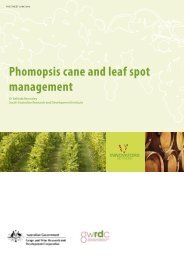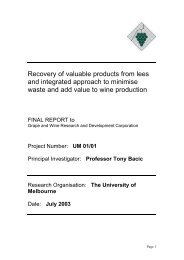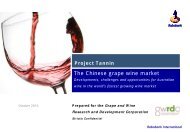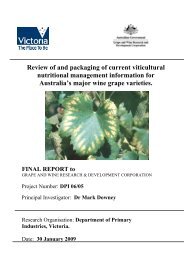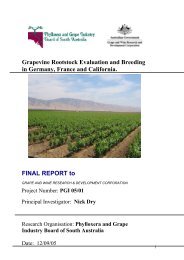Identification of the major drivers of 'phenolic' taste in ... - GWRDC
Identification of the major drivers of 'phenolic' taste in ... - GWRDC
Identification of the major drivers of 'phenolic' taste in ... - GWRDC
You also want an ePaper? Increase the reach of your titles
YUMPU automatically turns print PDFs into web optimized ePapers that Google loves.
AWRI: <strong>Identification</strong> Of The Major Drivers Of ‘Phenolic’ Taste In White W<strong>in</strong>es<br />
Two non flow-through fractions also conta<strong>in</strong>ed quercet<strong>in</strong>-3-glucuronide as a significant proportion <strong>of</strong> <strong>the</strong><br />
phenolic compounds that absorb maximally at 370 nm. Various flavonol glycosides (<strong>of</strong> which quercet<strong>in</strong>-<br />
3-glucuronide is a member) have been reported to elicit astr<strong>in</strong>gency at very low concentrations (Scharbert<br />
et al. 2004; Brock and H<strong>of</strong>mann 2008). However, <strong>of</strong> <strong>the</strong> two fractions that conta<strong>in</strong>ed quercet<strong>in</strong>-3-<br />
glucuronide (F1 Fiano and F1 Riesl<strong>in</strong>g), only one was perceived to be more astr<strong>in</strong>gent than <strong>the</strong> low<br />
phenolic control, and only marg<strong>in</strong>ally so. Therefore quercet<strong>in</strong>-3-glucuronide does not seem to contribute<br />
to <strong>the</strong> astr<strong>in</strong>gency <strong>of</strong> <strong>the</strong>se fractions.<br />
Add<strong>in</strong>g phenolic fractions (regardless <strong>of</strong> source or type) resulted <strong>in</strong> a consistent reduction <strong>in</strong> perceived<br />
burn<strong>in</strong>g sensation and acid after<strong>taste</strong>. At this stage <strong>of</strong> <strong>the</strong> project, <strong>taste</strong>rs were tra<strong>in</strong>ed to understand <strong>the</strong><br />
notion <strong>of</strong> hotness result<strong>in</strong>g from alcohol, but had not been <strong>in</strong>troduced to <strong>the</strong> possibility that o<strong>the</strong>r forms <strong>of</strong><br />
back-palate hotness might exist. The base w<strong>in</strong>e had been extensively stripped <strong>of</strong> its phenolics, so it could<br />
be reasonably assumed that any hotness aris<strong>in</strong>g from <strong>the</strong> base w<strong>in</strong>e was alcohol derived. In this context,<br />
every phenolic fraction, regardless <strong>of</strong> its source or type reduced <strong>the</strong> perception <strong>of</strong> burn<strong>in</strong>g sensation<br />
(presumably result<strong>in</strong>g from alcohol). Of all <strong>the</strong> fractions, <strong>the</strong> F3 fraction from <strong>the</strong> Gerwurztram<strong>in</strong>er was<br />
<strong>the</strong> most effective <strong>in</strong> reduc<strong>in</strong>g <strong>the</strong> burn<strong>in</strong>g after<strong>taste</strong> (p=0.0074). It conta<strong>in</strong>ed a higher proportion <strong>of</strong><br />
caffeic and coumaric ethyl esters that <strong>the</strong> o<strong>the</strong>r fractions amount<strong>in</strong>g to 97% <strong>of</strong> <strong>the</strong> compounds active at<br />
320 nm.<br />
Phenolic addition generally resulted <strong>in</strong> a reduction <strong>in</strong> <strong>the</strong> perception <strong>of</strong> acid after<strong>taste</strong>. The three fractions<br />
that resulted <strong>in</strong> <strong>the</strong> greatest reduction <strong>in</strong> acid after<strong>taste</strong> had a common feature <strong>in</strong> that <strong>the</strong>y were all rich <strong>in</strong><br />
free hydroxyc<strong>in</strong>namic acids. However, F2 from <strong>the</strong> Gerwurztram<strong>in</strong>er was also abundant <strong>in</strong> <strong>the</strong>se, but its<br />
addition only marg<strong>in</strong>ally decreased <strong>the</strong> acid after<strong>taste</strong>.<br />
For <strong>the</strong> first time we show that phenolic addition has little effect on acidity when perceived <strong>in</strong> mouth, but<br />
significantly affects <strong>the</strong> <strong>in</strong>tensity <strong>of</strong> acidity once <strong>the</strong> w<strong>in</strong>e has been expectorated. The reason for this is<br />
unclear, but due to its implications on style perception this result should be pursued.<br />
The Fiano F2 fraction differed from <strong>the</strong> o<strong>the</strong>rs <strong>in</strong> that it was rich <strong>in</strong> monomeric flavan-3-ols (epicatech<strong>in</strong><br />
gallate, catech<strong>in</strong> and epicatech<strong>in</strong>). It was also perceived to be more bitter than <strong>the</strong> control than any o<strong>the</strong>r<br />
fraction. Epicatech<strong>in</strong> gallate has recently been shown to react most strongly amongst <strong>the</strong> common<br />
monomeric flavanols found <strong>in</strong> w<strong>in</strong>e with <strong>the</strong> human bitter <strong>taste</strong> receptor hTAS2R39 (Narukawa et al.<br />
2011). It also was deemed to be bitter and astr<strong>in</strong>gent <strong>in</strong> human <strong>taste</strong> tests, and it elicited a <strong>taste</strong> that was<br />
<strong>the</strong> least preferred amongst <strong>the</strong> common monomeric flavanols; epicatech<strong>in</strong>, epicatech<strong>in</strong> gallate,<br />
epigallocatech<strong>in</strong> and epigallocatech<strong>in</strong> gallate (Narukawa et al. 2010). The o<strong>the</strong>r two flavanols found <strong>in</strong><br />
this fraction, catech<strong>in</strong> and epicatech<strong>in</strong> are also known to contribute to bitterness (Kielhorn and Thorngate<br />
1999; Peleg et al. 1999). Interest<strong>in</strong>gly, all <strong>the</strong> above-mentioned authors have reported that <strong>the</strong> monomeric<br />
flavanols elicit astr<strong>in</strong>gency as well as bitterness. Hufnagel and H<strong>of</strong>mann (2008) concluded that flavanols<br />
did not contribute to astr<strong>in</strong>gency <strong>in</strong> red w<strong>in</strong>e, a conclusion supported by <strong>the</strong> data here. The Fiano F2<br />
fraction whilst be<strong>in</strong>g slightly more bitter than <strong>the</strong> control was not more astr<strong>in</strong>gent. Hufnagel and H<strong>of</strong>mann<br />
(2008) also suggested that <strong>the</strong> <strong>major</strong> bitter compounds <strong>in</strong> red w<strong>in</strong>e were ethyl esters <strong>of</strong> caffeic, vanillic<br />
Page | 52




